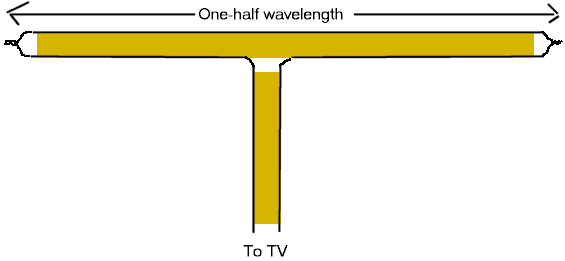A simple, efficient TV antenna
A folded dipole is an efficient TV antenna that is easy to construct. It will not compete with a good high-gain directional antenna, but it sure beats rabbit ears.
This antenna is optimized for a single channel, though it will often work acceptably on others. Design it for the signal that is giving you the most trouble, and perhaps it will work well for the rest. If not, build another for the next channel -- they are cheap.
Construction
The antenna is made from "300 ohm twin-lead" the brown or black ribbon-like TV line that we all used before the days of cable television. There are two conductors running along the edges of the ribbon. You need to know the frequency of the station, which you can find out by calling the station or doing a web search. If you know the real channel number, you can use the appropriate formula below. Be aware, however, that the channel number the station advertises may very well be a "virtual channel" chosen for historic reasons, not its actual broadcast channel.
For channels 2 - 4, the frequency is given by
f (in MHz) = (6 x channel_number) + 45.
For channels 5 and 6, the frequency is
f (in MHz) = (6 x channel_number) + 49.
For channels 7 -13, the frequency is
f (in MHz) = (6 x channel_number) + 135.
For channels 14 and above
f(in MHz) = (6 x channel_number) + 389.
Cut off a piece of twin lead one-half wavelength, where
wavelength on twin lead (in meters) = 0.95 x 300 / f (in MHz).
(The factor of 0.95 is the assumed velocity factor of the common mode signal on the twin lead.)
(Example: for channel 2, the frequency is (6 x 2) + 45 = 57 MHz, so the wavelength on twin lead is 0.95 x 300/57 = 5.00 meters, and the antenna should be 5.00 meters/2 = 2.5 meters.)

Strip the insulation off just enough of each end to be able to twist the conductors together and solder. This is the "folded dipole" antenna.
Next you need to connect it to a long section of twin lead to bring the signal to your TV. The long piece leading to your TV is the transmission line.
Cut ONE of the two conductors of the antenna at the midpoint, and strip a half inch or so of insulation from each piece. Strip insulation from a half inch of insulation from the conductors of the long piece of twin lead. Attach the wires from the transmission line to the wires at the midpoint of the conductor, as shown above. Solder.
Attach the opposite end of the transmission line to the 300 ohm input of your TV. If your TV has only 75 ohm coaxial cable inputs, you will need to buy a 300 ohm to 75 ohm transformer at Radio Shack or other electronics store.
Mounting
The antenna should be mounted broadside to the station of interest. The higher it is mounted, the better it will perform. Do not mount the antenna near metal, and do not run the transmission line very close to metal objects. Do not leave excess transmission line in a coil: trim it close to the desired length.
Attic installations work pretty well. If you are in a dorm room or apartment, you can tape or thumbtack the antenna to a wall or ceiling, though wiring may degrade performance. Move it around for best reception.
Further improvements
The signal strength and ghost rejection can be improved significantly by adding a reflector and perhaps a director. For the spacings below, use the formula for wavelength in air, not wavelength in twin lead:
Wavelength in air (in meters) = 300/ f(in MHz)
Reflector
Cut a single piece of wire about 5% longer than your antenna. Do not use twin lead for this wire; use a single uninsulated wire. Mount it parallel to the antenna, about 0.2 wavelengths (in air) away on the side opposite the TV station. There is NO electrical connection between this wire and the antenna.
Director
For some additional improvement in reception, cut a similar piece of wire about 5% shorter than the antenna, and mount it parallel to the antenna on the side toward the station, about 0.15 wavelengths (in air) from the antenna.
Please send comments to matthews@wfu.edu.
[an error occurred while processing this directive][an error occurred while processing this directive]